As a child, I had heard some stories about my ancestors, in particular, about clashes between Pancho Villa and a distant relative, something about someone “being strung up by their thumbs”. However, as a young boy, growing up in San Diego, California, the stories didn’t mean anything to me, and they were stored deep within my mind for retrieval much later. In my youth, the ’50s, being of Mexican heritage in San Diego, and living in an all white suburban neighborhood, was not a ethnic feature to be made public; Hispanics had not yet openly declared the importance of their heritage in the golden state of California.
The discovery of cousins from my mother’s family (the Terrazas) began innocently on an unplanned, unscheduled trip to Chihuahua, Chihuahua, Mexico in 1990.
On to Chihuahua: With my wife, Helen, we enjoyed a short stay with her father and his family at their home in El Paso, Texas, before departing for our first trip to the city of Chihuahua, home of my mother’s family for several generations. Our trip started at the Greyhound bus station in El Paso, from there we were transported to the central bus terminal in Ciudad Juarez. It was easy enough to purchase tickets at the terminal for continuation on to Chihuahua, and soon we were on board and on our way. As we have done a few times before, we had not made hotel or rental car reservations; we were to let events unfold, as fate would deliver, and in conversing with the locals, in Spanish, for assistance.
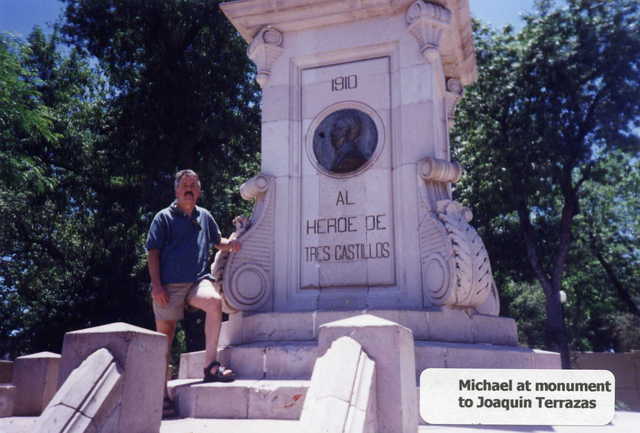
After arrival at the central bus terminal we hailed a cab and asked for a recommendation for a modestly priced hotel, and he took us to a small establishment a short distance outside of downtown. A decent recommendation.
Our adventure began the next morning when we set out, on foot, to discover the central downtown area. As we walked down the main street, across from the Cathedral, I noticed an outdoor sign for the office of the city recorder, and we entered. We approached the young woman sitting at the front desk, and I, in my modest grasp of the Spanish language, told her that we were looking for information on the Terrazas family. She promptly arose, and excused herself, in order to retrieve her supervisor, Sr. Ruben Beltran Acosta. Sr. Acosta turned out to be a treasure trove of information, and he was genuinely pleased that we had come into his office. Sr. Acosta is known as the cronista, that individual who holds the colorful stories and history of his/her town.
Sr. Acosta devoted a great deal of time, and much paper, informing us of sites we should visit, and of immediate relatives that we might call upon. Each time that he wanted to record new information, he reached over and grabbed a fresh sheet of white bond paper, and produced either written information, or a rough drawing of a monument. We came away with a wonderful collection of hand written notes and rough drawings, which became the launching tools for this new adventure.
Here are the highlights of the sites that he pointed out to us, and what we discovered at each:
The Cathedral: our next stop after visiting with Sr. Acosta. At the rear of the church is the entrance to a museum that is actually beneath the church, with many beautiful paintings and artifacts of the history of the Catholic Church in Mexico. The woman attendant, as we discovered, is my second cousin, Concepcion, and she received us very warmly. We spent about one hour with her, toured the museum, talked about the family, and she gave me a rough photocopy of Terrazas family genealogy, the first history I had ever seen of my mother’s family. Apparently, Sr. Acosta alerted her of our presence, as she had the genealogy papers ready to hand to us. Concepcion also spoke of her cousin, Teresa Siquieros, who lives in the city, and gave us her address.
Monument to Colonel Joaquin Terrazas: On the outskirts of the city is a tall and impressive, although aging, monument to Joaquin Terrazas, my great-great grandfather, a Colonel in the Mexican Army, and the heralded conqueror of the Apache Indians. The Apaches, forced out of the United States by the westward expansion of new immigrants, with the help of the US Calvary, moved their tribes to Northern Mexico: the state of Chihuahua. The Apaches terrorized the territory, stealing cattle, attacking ranches and their inhabitants; the state was under siege. Joaquin’s cousin, Governor Luis Terrazas commissioned Col. Terrazas, to lead a company of Army and civilian riflemen into the vast mountain ranges north of the capital city, to find and eliminate this threat by the Apaches to the people and properties of the state. In this mission he was successful, and he returned to the city as a great hero. I had never before heard of this man, or his fame in Chihuahua, from my mother or any of her siblings. I recently read a book that had the opening line: “Mexicans are to forgetting, what the Jews are to remembering”. And I find this to be the case in my family.
Burial Site of Luis Terrazas: When one speaks of, or reads the history of Chihuahua, you cannot escape the person of Don Luis Terrazas. Sr. Terrazas, twice governor of the state, majority land owner in the entire state, and el jefe of the largest cattle ranching operations in all of Mexico, is buried on the grounds of the church of Our Lady of Guadalupe, along with his wife, Carolina, just one block up from the monument to Joaquin Terrazas. This was a remarkable discovery, courtesy of information from Sr. Beltran Acosta. The front and both sides of the church edifice hold the burial sites of some of Chihuahua’s most prominent citizens. Luis & Carolina are positioned at the front and to the left of the walkway leading to the front doors. I have never before seen church grounds with burial sites on three sides. Also, I had never before heard about Luis Sr., although I later learned that the story of a relative being strung up by their thumbs by Pancho Villa’s forces was actually his son, Luis Jr. It would be much later, after returning home, that I would begin my own genealogy research. It was then that I learned of the power that Luis wielded, as governor and leading businessman. But also the dark side, how he kept his ranch workers in eternal indebtedness to him by paying them in script, and thus in a servitude passed on to their children, while he amassed larger land holdings and wealth. I came to detest his role in the family ancestry.
Mausoleo de los Chihuahuenses Ilustres (Mausoleum of the famous men of Chihuahua): On the outskirts of the city, close to the university, in a sports park, is a modest size, older rotunda, with the names of Chihuahua’s most famous men – “Chihuahuenses llustres” – inscribed into the stone work. Among these honored men is Joaquin Terrazas, my great-great grandfather. Underneath the monument is housed the remains of these 14 men. A small path of steps and an old wooden door mark the entrance to this humble mausoleum. As I write this story, I am in receipt of a new booklet and video, produced by the state of Chihuahua, and displaying the new monument/mausoleum, dedicated earlier in 2004, to house the remains of these men. The video captures the entire ceremony, removal of the boxed remains, each draped with the flag of Mexico, and the solemn military procession from the old monument to the new. There was a very impressive ceremony, including a large military and government participation, and a transfer of the boxes into the walls of the new mausoleum below… I sincerely wish I could have been there!
The home of Teresa Siquieros: On this first visit to Teresa’s home, after some difficulty in finding the street, Teresa was not at home – her housekeeper informed us she was in El Paso visiting her daughter. However, on our second visit to Chihuahua we did meet Teresa, her husband Ramon, and at their invitation we spent three days and two nights at their home. An interesting follow-up note to the first visit to her home: Teresa found out, probably from Concepcion, that Helen and I had been in town, and weeks after our visit, while at the home of her daughter, Teresa called our home and introduced herself! She extended much love and a warm invitation to stay at her home on our next visit; what a wonderful outreach to us, and the beginning of a new expansion of family.
In one of the bedrooms in her home, mounted on the wall rests a large portrait of Col. Joaquin Terrazas, with his Army issued rifle and saber below.
El Palacio de Gobierno (Government Palace): Sr. Beltran Acosta also recommended a visit to this very old, three story square complex, built in Spanish style with a large courtyard in the center. We were not prepared for what we were to view: a compressed history, in full-size mural format, of the state of Chihuahua, painted floor to ceiling on the walls of the main floor. We took one of the printed guide pages from the attendant and proceeded to follow the mural, left to right, admiring both the workmanship of the painter, as well as the remarkable story of this enormous state. At the third wall panel we gazed upon paintings of Luis Terrazas, as governor, meeting with other power brokers, and working out some new direction for the state. Next to that depiction were two paintings of Col. Joaquin Terrazas, Army rifle raised over his head, and shown as conquering the Apache Indians below. This Mexican tradition of painting murals is powerful and most impressive; I am so pleased that we discovered this display!
El Centro Cultural de Chihuahua (the Chihuahua Cultural Center): This civic building we discovered on our own, and out of the need to find a public restroom! This impressive looking three story building, wedged on a corner of the main street leading to downtown, features large wrought iron entry gates and porticos over each exterior window on all floors. Upon entering into the impressive Mexican foyer, we met Juan, the caretaker. He told of a public exhibit on the second floor, featuring the history of Indians who resided in the Nuevo Casas Grande region of the state, in living spaces entirely underground. We toured the exhibit and found it to be quite impressive. The cultural center has a large interior patio area, very Spanish in design, with the rooms on all three floors opening towards this patio. Juan kindly pointed the way to the restrooms as well. As we prepared to exit, Juan asked us to sign the guest register, and while I signed the book, my wife made a passing comment that we were looking around the city for information on the Terrazas family.
If you could have seen the face of this quiet man come to life! He escorted us outside to the sidewalk, and pointed to the large wrought iron initials on the face of the building “LT”; he told us that we are visiting the former residence of Luis Terrazas, twice governor of this state! Juan then lead us back inside and into two separate offices, each with it’s own built-in vault, and the name “Luis Terrazas” in gold leaf lettering on the door. Juan went into further detail on stories of a secret escape tunnel running below the residence, and of Pancho Villa’s forces taking over the building at the start of the revolution. This was pretty exciting information! Helen and I took many photos, including a couple with Juan, and added them to the growing Terrazas/Chihuahua portfolio. On a return trip to Chihuahua in 2002, we took a copy of a photo that included Juan and delivered it to the Center; fortunately, he was working and was so pleased to see us, as well as to receive a copy of the photo!
A phenomenal and exciting new chapter in my life was beginning with this discovery of family in Chihuahua. Especially, cousin Teresa who was as enthusiastic at meeting us, as we were of her!
The thrill of researching my maternal genealogy was ignited, and I began in earnest to delve into Internet web sites like Ancestory.com, to tap into other people’s knowledge about this historical Mexican family. This new endeavor in my life also awakened me to the need to become closer to my uncles, those remaining siblings of my now deceased mother. I made copies of the family tree that Teresa had given me, and prepared packets that included photos which I had taken on both trips; these I cheerfully provided to three uncles, and to a cousin in Mexicali, who also had done family research. In short order, my family had expanded. My Mexican heritage, for so long a dormant part of my being, was now alive with importance and the need to know more!
And so we are cousins, somos primos! My horizons have expanded. My appreciation of immediate and extended family, heredity and the importance of each has been reborn. I seek to remain close to these newly discovered cousins, and to find and meet others!
Somos primos, has never meant more to me than the present!

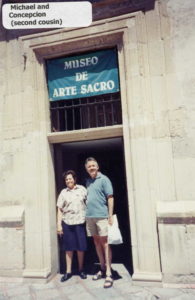
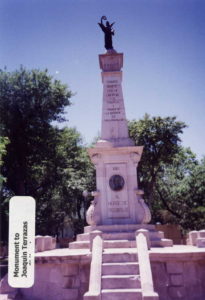
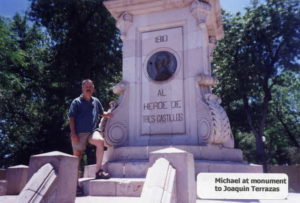
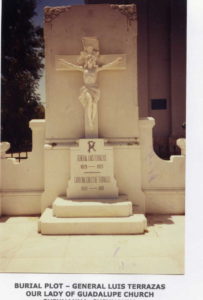
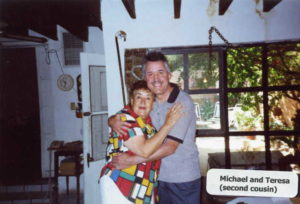
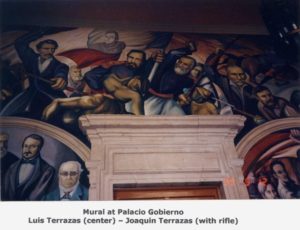
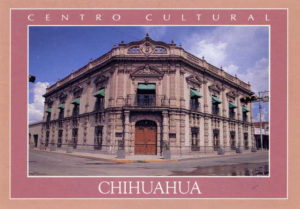
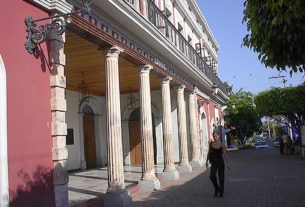
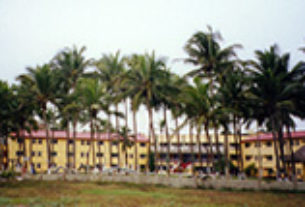
I am trying to find information on the Terrazas family in Spain, specifically the family of Violante Terrazas, who may have been a native of the Villa de Cortegana, Huelva, Andalucia. She was the wife of Hernando dela Mancha, and the mother of Diego dela Mancha, who emigrated to Mexico around 1560. Apparently Diego named a daughter after his deceased mother, even giving her the surname of Terrazas. That daughter later married Miguel Gallegos in Durango, and their son Luis Gallegos y Terrazas settled in New Mexico, and is the progenitor of the Gallegos family there. What I am trying to establish is a family connection to the Terrazas discussed in this article.
Hi Pat, my name is Mychelle Gallegos and I
am currently working on my son’s family tree and genealogy (Terrazas) as well as my husband’s (Gallegos) and I too am curious as to how they are related because I’m seeing the names come up together. I’m having a harder time pinpointing the Terrazas line as I don’t have much information on my son’s side except his grandfather and possible names of his parents. I would love to speak to you about the possibility of sharing information to see if I can make some more connections.
I stumbled upon your article while researching some of my family history. my grandmother and 4 of her brothers immigrated to Chihuahua, Mexico from Germany in the early 1990s, following an “uncle” who was already there. Evidently, their uncle-in-law had a brother named Bernhard (Bernardo) Bucher (1860-1912).
Bernardo Bucher married Teresa Terrazas (born 1870) and were parents to Jorge Bucher Terrazas (1901-1977).
Did these names come up for you at all?
Al fallecer en 1586 su primer esposo y dejar en orfandad a 5 hijo, en ese mismo año se casa con el C. Alonso de Valenzuela con quien tiene al también C. Miguel Valenzuela Terrazas, que al igual que los hijos y nietos de Miguel Gallegos algunos de ellos dejaran Guadiana, hoy estado de Durango para establecerse en la minería del naciente S. José del parral a mediados del siglo XVII continuando hacia el norte de Nueva Vizcaya a Chihuahua e incluso Nuevo México hasta antes de la rebelión de los indios pueblo. Es hacia finales del siglo XVII y principios del XVIII que inician a utilizar el apellido Terrazas o Valenzuela en forma indistinta en el valle de S. Bartolome hoy Allende, S. Fco. de Conchos, S. Javier de Satevo, Babonoyaba, hasta llegar a la villa de S. Felipe lo que hoy es la ciudad de Chihuahua e incluso todo el estado. Que habrá diferenciarse del primero que acompaño como Conquistador a Hernán Cortes y su hijo criollo el Poeta. Así como mas reciente a los Terrazas establecidos en la huasteca Potosina que identifica al municipio de Axtla de Terrazas. Mi nombre es Miguel Augusto Morales Terrazas, siendo descendiente del patriarca D. Lucas Terrazas y de Soto, 1729-1791. [email protected]